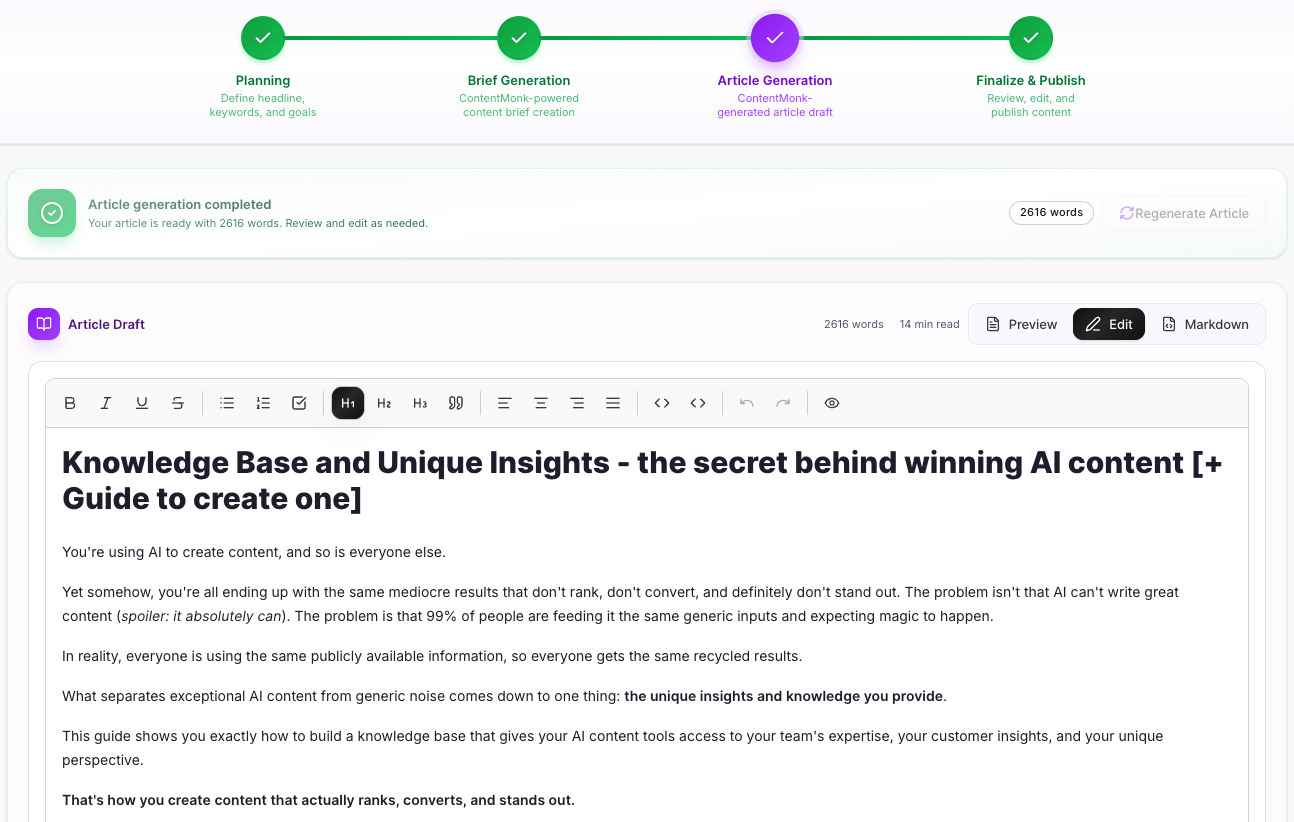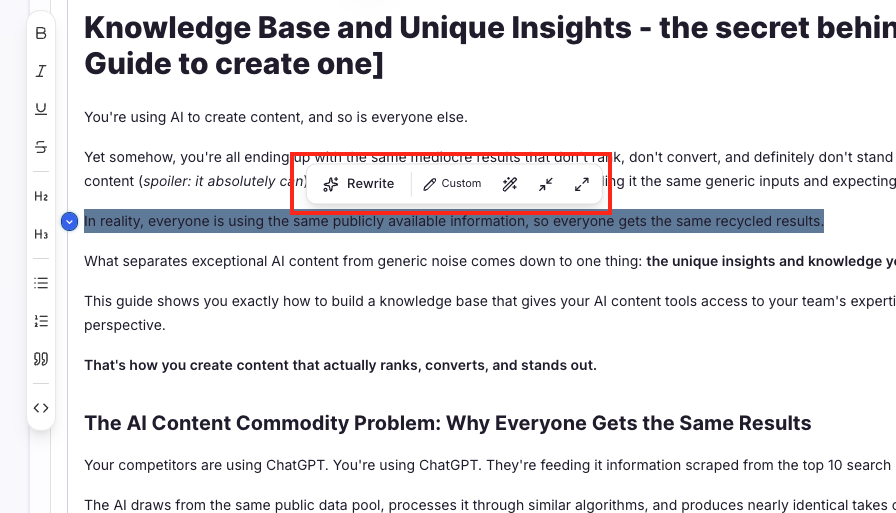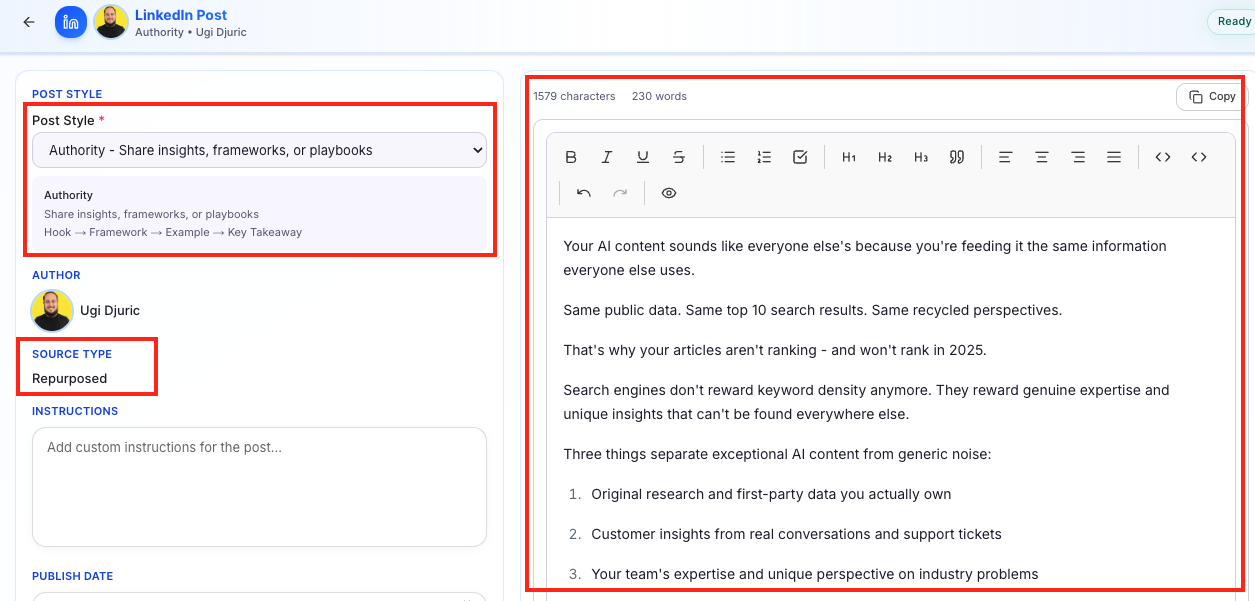
Content is only as good as insights and value inside. In this article, learn how to build complex knowledge base, full of unique insights that can be accessed by your AI content software.
You're using AI to create content, and so is everyone else.
Yet somehow, you're all ending up with the same mediocre results that don't rank, don't convert, and definitely don't stand out. The problem isn't that AI can't write great content (spoiler: it absolutely can). The problem is that 99% of people are feeding it the same generic inputs and expecting magic to happen.
In reality, everyone is using the same publicly available information, so everyone gets the same recycled results.
What separates exceptional AI content from generic noise comes down to one thing: the unique insights and knowledge you provide.
This guide shows you exactly how to build a knowledge base that gives your AI content tools access to your team's expertise, your customer insights, and your unique perspective.
That's how you create content that actually ranks, converts, and stands out.
Your competitors are using ChatGPT. You're using ChatGPT. They're feeding it information scraped from the top 10 search results. You're doing the same thing.
The AI draws from the same public data pool, processes it through similar algorithms, and produces nearly identical takes on every topic.
This is the content commodity trap, and it's why your articles aren't ranking despite following every best practice you've read.
Search engines and LLMs don't care about keyword density anymore. Instead, they're looking for signals that your content offers something genuinely useful that can't be found everywhere else.
Google's algorithms care about expertise, experience, authority, and trust. It other words, that means:
If an LLM can generate your article from publicly available information in 30 seconds, why would it rank you over the 500 other sites publishing the same recycled takes?
This is the equation that matters: the quality of your content is directly proportional to the quality of insights you provide to your AI system. Better inputs create better outputs.
When you give your AI tools access to customer interview transcripts, sales call recordings, product team insights, and proprietary research, you're giving it raw material that nobody else has. Your knowledge base becomes your competitive moat, and every unique insight you capture widens that gap between your content and the generic noise flooding search results.
You've figured out that your AI needs better fuel than what everyone else is feeding it. But how exactly do you get your unique insights into the system?
As we're about to see, there are two primary methods
Your AI content system requires access to your unique knowledge, but not everything should be stored in the same place. Think of it like cooking: you have a pantry with ingredients you use regularly, and you have a specific recipe with instructions for tonight's dinner. Your AI content operation works the same way.
The first method is a knowledge base that stores your intellectual property. The second is article-specific instructions that guide individual pieces. Both matter, but they serve different purposes.
Most people would build their knowledge base by adding a brand voice document, perhaps a style guide, and consider it done (that's what we're seeing across custom GPTs).
A real knowledge base is where your entire team's knowledge lives in a format your AI can access. The key documents are:
The knowledge base should act as a general repository.
Not every document should be used in every article, but the relevant pieces get pulled when needed.
If you create your knowledge base within ContentMonk, before writing briefs and articles, it will semantically search your knowledge base for only the most relevant insights (this means it will search your knowledge base based on context, not keywords).
With a content knowledge base organized in this manner, your AI can reference your product's specific features when writing about the problems those features solve. It can cite real customer scenarios instead of generic examples, and it can adopt the perspective and terminology your team actually uses.
This is your institutional knowledge made accessible. Everything your team knows, captured in a way that scales beyond the people who originally said it.
While your knowledge base provides the general intellectual property, article-specific instructions give targeted direction for individual pieces. This is where you communicate your vision for a particular article.
These instructions answer questions like:
Let's say you're writing about a problem you've seen come up in three recent sales calls - that context belongs in the article instructions, not your general knowledge base. Or you want this piece to challenge a common misconception in your industry. That strategic direction guides this article specifically.
Article-specific instructions also let you include unique insights that apply only to this topic. An interview you conducted with your CTO about a specific technical challenge, a new data point from a recent customer survey, or a perspective that connects to current events or recent changes in your market.
ContentMonk made it easy to add your instructions when planning your article. Just click on the "mic icon" and record yourself speaking about that topic for 1-3 minutes.

The distinction between the knowledge base and individual instructions matters because it keeps your knowledge base focused on evergreen institutional knowledge while giving you flexibility to customize each piece.
You're not cluttering your repository with one-off insights, and you're not forcing every article to reference everything you know.
Together, these two methods create a system where your AI content software (such as ContentMonk) has access to your team's collective knowledge and receives specific direction for each piece it creates.
First-party insights come from inside your organization and are proprietary. Third-party insights come from external sources and add credibility to your perspective.
You need both if you want to create really extraordinary articles that rank, build trust, and convert.
You'll find that first-party insights are your secret weapon because nobody else has them. This is your customer analytics, behavior patterns, product usage data, and the specific problems you've solved that competitors haven't encountered.
It can also be the transcript from your sales call where a customer explained why they chose you over three alternatives.
It's your product team's opinions about why certain features exist and what trade-offs you made.
This is where your unique perspective resides.
When your customer success team notices that companies using feature X in a specific way get better results, that's first-party insight.
When your CEO has a contrarian take on where the industry is heading based on deal conversations, that's first-party insight.
This data doesn't exist on Google because it's yours alone.
The problem is that most teams have this knowledge scattered across Slack messages, recorded sales calls nobody rewatches, and inside the heads of people who've been there for years. Your AI can't access insights locked in someone's brain or buried in your CRM. Building a knowledge base that captures this proprietary intelligence is what separates exceptional content from recycled noise.
In the later sections, I will show you our proven process for extracting this information from industry experts.
Third-party insights lend credibility and context to your first-party perspective.
This includes:
For example, when Gartner publishes research showing specific buyer preferences, you didn't create that data, but it supports your argument.
Interviewing external experts on topics where you need an outside perspective is third-party insight. Pulling in quotes from your customers adds validation beyond your internal viewpoint. Citing relevant statistics from authoritative sources helps readers trust that you're not making unproven claims.
The mistake most content teams make is leaning too heavily on third-party insights because they're easier to find.
You can search statistics and quote industry reports all day. However, that's something that everyone else is also doing. The magic happens when you use external data to reinforce your unique internal perspective, not replace it.
Great AI content seamlessly blends both types. Your proprietary customer data becomes more credible when you show how it aligns with or challenges industry research.
You've identified your unique insights. You understand why they matter. Now comes the practical question: how do you actually get all that knowledge into a system that your AI can access and use?
The good news is that building a knowledge base doesn't require technical expertise or complex workflows (if you're using a good AI content software).
Most AI content platforms, including ContentMonk, have a dedicated knowledge base section where you can upload documents directly.
Inside ContentMonk, for example, the interface is straightforward:
Start by gathering the assets you already have.
Product documentation is the obvious starting point, but don't stop there. Pull transcripts from sales calls, grab recordings from customer success sessions where users explained how they actually use your product.
Find internal Slack threads where your team solved complex problems. Collect presentation decks from webinars, conference talks, or internal strategy sessions.
You can also use ChatGPT/Claude to generate these documents (considering that you have a lot of memory and relevant conversation there).
The assets you already have are just the foundation. The real competitive advantage comes from systematically extracting tribal knowledge from your team members who interact with customers, build products, or solve problems daily.
We like to schedule monthly sessions with:
Treat these conversations like interviews, not meetings. Your goal is to extract the insights they've developed through repeated exposure to customer problems, rather than collaborating on messaging.
This process is time-consuming upfront. Recording, transcribing, and organizing these conversations takes effort. But you're building a repository that compounds in value over time.
Each conversation captured today becomes an asset that your AI can reference for months or years, as long as it remains relevant.
You should also repeat the same process with people outside your company.
When I say that content marketers should "act as journalists", I literally mean that.
Look for stories worth telling and gain secret knowledge and unique insights from others.
Then use those to write mind-blowing articles in minutes with ContentMonk.
Here's where things get interesting. Advanced AI content software like ContentMonk automatically vectorizes and indexes every article you publish.
In other words, this means that each piece of content you create becomes part of your knowledge base, making it accessible for future articles.
This creates a compounding effect. Your first articles draw from your initial knowledge base. But as you publish more content, your system learns which topics you've already covered, which angles you've explored, and which unique insights you've shared.
Future articles can reference, build upon, or contrast with previous work without you manually tracking everything you've written.
The more you write, the better your system becomes at maintaining consistency, avoiding repetition, and connecting ideas across your content library. Your knowledge base evolves from a static repository into a dynamic system that grows smarter with every article you publish.
The tools have caught up. AI content systems can write briefs, draft articles, and repurpose content across formats without you touching a single manual template.
The bottleneck is no longer the technology. It's whether you have something worth saying.
Content operations have split into two distinct functions: what the AI handles and what only humans can do. The division isn't arbitrary. It reflects where machines excel at speed and consistency, and where human judgment, curiosity, and strategic thinking remain irreplaceable.
AI content platforms like ContentMonk take care of the mechanical heavy lifting that used to consume 80% of your team's time.
ContentMonk will, for example, based on your knowledge base and instructions, write a complete brief in less than 60 seconds.

Then, when you're satisfied with the brief (you can edit it in the meantime), ContentMonk will write an entire, near-perfect article in less than 2 minutes.

Then, when it comes to polishing articles, ContentMonk features an AI editing tool. Simply select a sentence or paragraph, and it will be edited according to your needs.

And after you publish your piece, you can repurpose it into LinkedIn posts or other content formats for your entire team to distribute with just three clicks. For example, I repurposed this article into an authority-style Linkedin post in literally 15 seconds - and I would need the same amount of time and effort even if I want to create a similar post for 20 teammates from this one article.

So if ContentMonk can generate the perfect content based on your inputs, what's your role?
Your job hasn't disappeared. It has concentrated on the parts that actually differentiate your content from everyone else's. You're now responsible for three critical functions that AI can't replicate.
First, you're the strategist. You define the vision behind each piece of content. You decide what stories to tell, which problems to address, and how each article connects to your broader narrative. You determine whether a topic deserves 800 words or 3,000, whether it needs customer data or product specs, and how it fits into your content ecosystem.
Second, you're the journalist. You dig for the unique insights that become your competitive advantage. You schedule monthly interviews with subject matter experts on your team. You extract knowledge from sales calls, customer success conversations, and product development discussions. You identify the stories and perspectives that exist nowhere else on the internet.
Third, you're the systems operator. You feed your AI content system the necessary inputs to produce exceptional output. You upload transcripts, product documentation, and customer interviews to your knowledge base. You provide article-specific instructions that guide the AI toward your vision. You do light editing and polishing on the drafts that the ContentMonk produces.
Your knowledge base becomes the central nervous system for your entire content operation. Everything your team knows, every insight you've gathered, every perspective that makes your company unique gets stored in one accessible repository. From there, it flows into every piece of content you create.
The best content out there is written on top of the best insights. Your knowledge base and unique insights are the moat that turns generic AI output into content that ranks, converts, and stands out.
Start building your knowledge infrastructure today:
If you want to take your content ops to the next level and start creating exceptional articles in minutes, book a free 30-minute demo to see how ContentMonk can help you out.
Optimize your entire content operations, so you can spend more time researching and digging for unique insights.